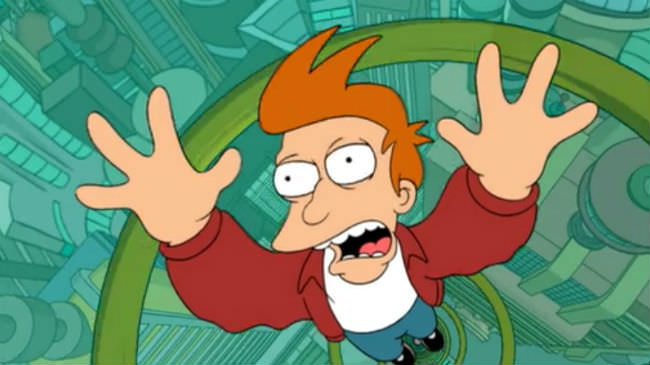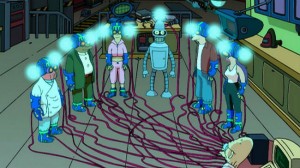The Futur(ama) Is Now

These Futurama bits may become real things. Maybe sooner than you think.
There are two types of people in this world: those who love Futurama and those who haven’t seen it.
The show caused some serious “feels” with episodes like Jurassic Bark and inspired various Internet memes with Fry, Professor Farnsworth and Doctor Zoidberg.
And if you’ve spent any time on sites like io9, you’ve read posts about how some of the jokes are rooted in real science. More than a few writers had backgrounds in advanced mathematics, making Futurama a nerdier version of The Simpsons.
Based on some of the headlines I’ve read, I think the show’s writers had a good idea of where technology was going.
It’s a mind blowing realization after reading a news piece and thinking of a Futurama episode from a few years back on the same topic.
So, here are some mind blowing (I think) stories ripped right out of Futurama.
Mass Transit With Hyperloop

Excluding the intro and first episode, Futurama doesn’t waste time on tube travel and for good reason.
Any sci-fi fan can count the movies and shows that used tubes for transportation on both hands. (And the number of girlfriends they had on one).
With today’s special effects, tube transport isn’t exactly exciting. It’s a relic from a by-gone type of movie making. The idea of being sucked or pushed through a tube is ridiculous when you look at the way we get around now.
Don’t tell Elon Musk that.
Elon Musk is responsible for a few things you’ve heard of. He’s the head of Tesla Motors. He was one of the founders of PayPal. He started SpaceX, a privatized space program with the goal of reducing transportation cost in order to colonize Mars.
He’s also the idea man behind a tube-based mass transit called Hyperloop, and it’s exactly what it sounds like.
The Hyperloop, if it works and garners enough funding, is a super fast form of mass transportation.
How fast?
In theory, the Hyperloop could transport passengers from Los Angeles to San Francisco in 35 minutes. To cover the 350 miles, the Hyperloop would have to travel 600 miles an hour.
To put that in perspective, Japan’s bullet train peaks at 275 mph. A commercial jet like a Boeing 757 tops out at 610 mph.
The Hyperloop is projected to hit a max speed of 760 mph. Thats fast enough to travel from New York to LA in 3.5 hours.
That’s fast and it’s real. They’re building a test strip in Texas and if it works, Hyperloop will revolutionize the travel industry. Which means long lines at the airport are replaced with long lines at the tube sucking station.
Plug Into the Web With Your Brain
In the early seasons, one of Leela’s story’s involved figuring out where she came from. Bicyclops Built for Two focused solely on that.
The writers introduce another cyclops, Al Alcazar, and Leela tracks him down. Then she finds out he’s a shape shifting polygamist and is crushed.
At the episode’s start, when they finally got on AOL (remember that?), the crew donned VR helmets that injected them into the Internet. Well, DARPA wants to do something similar to what happened in that scene, but in reverse.
DARPA wants the Internet in your head.
The Defense Advanced Research Projects Agency (DARPA) is the reason you’re able to read this now. Way back when, they supported the ARPANET, an information system that used packet switching and TCP/IP technologies.
Both are fundamental elements to the online world. Without DARPA’s support, there wouldn’t be an Internet and you’d still be buying adult magazines from the gas station and watching dumb cat or nut-shot clips on America’s Funniest Home Videos.
So how are they going to do it?
The plan is to build a neural interface that translates the digital signal into something the brain can process. Think of it as a modem that goes into your cerebral cortex. The cerebral cortex (the wrinkled part of the brain) plays key roles in sensory perception (sight, sound, touch, smell), motor skills, and damn near everything else you do.
The idea is to put the signal directly into your brain, making wearable tech like Google Glass, Oculus Rift and Microsoft’s HoloLens obsolete. If the DARPA modem works, then you get the augmented reality without the clunky gear.
But the brain modem will have far more uses than watching cat videos on YouTube.
Since the cortex does everything, DARPA’s mind modem has the potential for more complex applications. Wiring a robotic limbs for amputees or quadriplegics is one example.
While the tech is crude now, the goal is to replace missing limbs with robo limbs that mimic the real thing, including sensory sensations like hot, cold, pressure and texture.
But a lot of folks will use it for porn, which would go well with robo love. Speaking of robosexuals…
Sharing With Robots
In I Dated A Robot, Fry goes through his checklist of things he’s always wanted to do. Including ride a dinosaur, see the edge of the universe and date the lovely actress Lucy Liu.
In Futurama, it’s possible to download famous personalities to a blank robot. Just download the personality from Nappster and go to town.
Current tech isn’t advanced enough to mimic a Lucy Liu-bot. But don’t you worry. While companies like Boston Dynamics are busy building death machines, others are working on less pants-wettingly scary doom machines.
Engineering Arts, a UK based company, is one of those companies. They make and sell a robot that can wear your face and talk to you about feelings. If you have $22,000 laying about and have some narcissistic issues, you can spend all day talking to yourself.
Don’t believe me? Fine. Check out this video of the SciBot mini in action.
The AI in the SciBot mini is a long away from passing the Turing Test. Even the company’s owner, Will Jackson, admitted the talking torso can’t do much more than hold basic conversations. But we’re living in a world where technology is advancing at an exponential rate.
Technology’s exponential advancement is called Moore’s law. Named after Gordon E. Moore, co-founder of a little computing company called Intel. Maybe you’ve heard of it. Anyway, in 1975, Moore observed that technology, processors specifically, would double their capacity every two years.
For the most part, Moore’s law has stood on solid ground. Improved processors, digital camera pixels and storage are a few examples of Moore’s law in action.
Since companies like Boston Dynamics and Engineering Arts are hell bent on making robots, let’s get them all the tech they need so we don’t have a world of nightmare inducing robo-strippers.
Once those companies figure out the nuts, bolts and wiring of our future robot overlords, it’s only a matter of time before we start to fall in love with them. People have been doing that for a while with their cars or video game characters. It’s called mechanophilia.
But it will be nice to have someone to love, given we’ll be unemployed by the time they take all our jobs by 2025.






